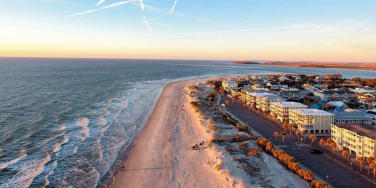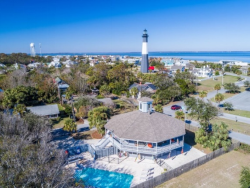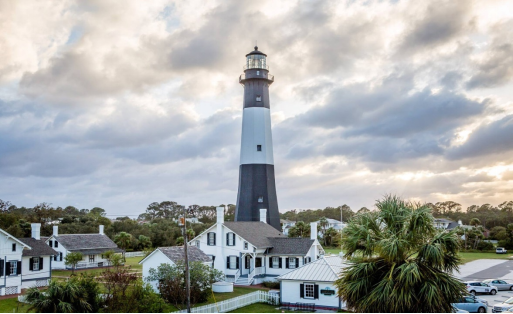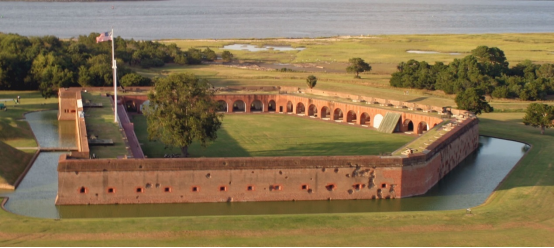Tybee Island, Georgia 作者: 来源: 发布时间:2021-07-20
I.Population and Area
₋Area
Land: 2.92 sq mi (7.56 km2)
₋Population
Total: 2,990
Density: 1,049.33/sq mi (405.12/km2)

II.Natural Geography
₋Tybee Island is a city and a barrier island located in Chatham County, Georgia, 18 miles (29 km) east of Savannah, United States. Though the name "Tybee Island" is used for both the island and the city, geographically they are not identical: only part of the island's territory lies within the city.
₋The island is the easternmost point in Georgia. The famous phrase "From Rabun Gap to Tybee Light," intended to illustrate the geographic diversity of Georgia, contrasts a mountain pass near the state's northernmost point with the coastal island's famous lighthouse.
₋As of the 2010 census, the city's population was 2,990. The entire island is a part of the Savannah Metropolitan Statistical Area.
₋Officially renamed "Savannah Beach" in a publicity move at the end of the 1950s, the city of Tybee Island has since reverted to its original name. (The name "Savannah Beach" nevertheless appears on official state maps as far back as 1952 and as recently as the mid-1970s.) The small island, which has long been a quiet getaway for the residents of Savannah, has become a popular vacation spot with tourists from outside the Savannah metropolitan area. Tybee Island is home to the first of what would eventually become the Days Inn chain of hotels, the oft-photographed Tybee Island Light Station, and the Fort Screven Historic District.
₋It is one of the few locations where the U.S. Air Force dropped an atomic bomb—by accident (during a botched 1958 military training exercise). Though the "Tybee Bomb" did not detonate (and, according to some reports, was not armed with a fuse), there has been ongoing concern, since the Mark 15 nuclear bomb lost during the mishap was never found.

III.GDP
₋The average salary in Tybee Island, GA is $39k. Trends in wages increased by 3.2 percent in Q1 2020. The cost of living in Tybee Island, GA is 12 percent higher than the national average. The most popular occupations in Tybee Island, GA are Director of Operations, Human Resources (HR) Manager, and Arborist which pay between $22k and $66k per year.
₋Website: https://www.payscale.com/research/US/Location=Tybee-Island-GA/Salary
IV.Industrial Characteristics
₋Tybee Island, Georgia attracts thousands of visitors each year to its beachfront, ocean access areas, restaurants, historic sites, gift shops, and much more. This section of the report provides information about visitors to the island Assessing and analyzing the annual expenditure patterns of Tybee Island visitors is useful from both a fiscally-oriented municipal viewpoint, but also from a local small-business perspective. Demographic, socio-economic, and geographic data of respondents was gathered. Visitors responded to a survey asking about spending on various accommodations (hotels, B&B, beach houses, friends, camping, etc.) and other categories such as (food/beverage, recreational equipment, tours/attractions, shopping and gifts, entertainment/nightlife, etc.). This information was compiled and compared across various subgroups of the visitors.
₋Website: https://www.cityoftybee.org/DocumentCenter/View/139/Tybee-Island-Tourism-Study-2015-PDF
V.Attractions
1.Tybee Island Light

₋Tybee Island Light is a lighthouse next to the Savannah River Entrance, on the northeast end of Tybee Island, Georgia. It is one of seven surviving colonial era lighthouse towers, though highly modified in the mid 1800s.
₋The current lighthouse is the fourth tower at this station, though neither of its first two predecessors were lit. The first tower was built at the direction of James Oglethorpe and was constructed of wood; erected in 1736, it was felled by a storm in 1741. The following year a replacement was erected, this time of stone and wood, but still without illumination; instead, it was topped with a flag pole. This tower succumbed to shoreline erosion.
₋The third tower was constructed in 1773 by John Mullryne, a brick tower originally 100 ft (30 m) in height. It was first fitted with a system of reflectors and candles, but this was upgraded to oil lamps after it was ceded to the federal government in 1790. A second tower was added to the site in 1822 to form a range. Both towers received Fresnel lenses in 1857, with the lower front tower being equipped with a 4th order lens, while the main tower received a larger 2nd order lens.
₋Confederate forces burned the light in 1862 during the Civil War and removed the lens as they retreated to Fort Pulaski. Reconstruction of the light was begun in 1866 but was delayed by a cholera outbreak. A new tower was constructed atop the first 60 ft (18 m) of the old tower, raising the height of the whole to 154 ft (47 m). This tower was equipped with a 1st order lens. The front beacon was now a 50 ft (15 m) wooden skeleton tower equipped with a new 4th order lens.
₋The main tower was severely damaged in a hurricane in 1871, and developed such serious cracking that a $50,000 appropriation was requested for its replacement. Instead a new front tower (which had already been moved twice) was constructed of iron. New keepers dwellings were constructed in 1881 and 1885. The following year the tower was shaken by the 1886 Charleston earthquake, which damaged the lens and caused further cracking of the brickwork; these were both however immediately repaired. In 1933 the tower was electrified and the station reduced to a single keeper. The beacon was automated in 1972.
₋Throughout its life the daymark of the tower was modified on numerous occasions. Originally all-white, the base and lantern were painted black in 1887; this was altered in 1914 and again in 1916, each time bringing the black at the top further down the tower until the illustrated configuration was reached. In 1967 the entire tower was repainted with a white base and a gray top. The gray faded severely and was painted black in 1970.
₋In 1999 a major restoration project was begun under the auspices of the Tybee Island Historical Society, who took possession of the light station in 2002 under the National Historic Lighthouse Preservation Act. As part of this project the tower was repainted in the 1916–1966 black-white-black daymark. The beacon is still a functioning navigational aid, still using its original lens. The site is open to the public and retains its keepers houses and auxiliary buildings as well as the lighthouse tower.
₋Address: 30 Meddin Dr, Tybee Island, GA 31328, United States
₋Website: https://www.tybeelighthouse.org/
2. The Tybee Pier & Pavilion

₋The Tybee Pier & Pavilion is located just off U.S. Highway 80 at the end of Tybrisa Street. Great location for fishing and people watching. Besides its spectacular view and great fishing location it s also a meeting place used for dances musical performances and special events. On the premises are picnic tables snack bar and public restrooms. Various festivals and events held here throughout the year. Open daily. Free admission. The pavilion can be rented for weddings family reunions and other social functions.
₋The original Tybrisa Pier & Pavilion stood for three-quarters of a century as a landmark on the South Atlantic Ocean. Built in 1891 by the Central of Georgia Railroad it became a well-known destination for day-trippers and seasonal visitors during a time when advertisements hailed Tybee as the Premier South Atlantic Resort. Its open dance floor amid a coastal setting made it a legendary stop on the Big Band tour and for five decades of entertainers. Fire destroyed it in 1967. Led by efforts of the people of Tybee Island Chatham County built the Tybrisa Pavilion II and dedicated it on the 9th of August 1996.
₋The Tybee Pier and Pavilion has become one of the premier entertainment centers in Chatham County.
₋Address: Tybrisa St, Tybee Island, GA 31328, United States
₋Phone: +1 912-652-6780
₋Website: https://tybeeisland.com/site/tybee-pier-pavilion/
3. Fort Pulaski National Monument

₋Fort Pulaski National Monument is located on Cockspur Island between Savannah and Tybee Island, Georgia. It preserves Fort Pulaski; during the American Civil War, the Union Army successfully tested rifled cannon in combat in 1862 there, the success of which rendered brick fortifications obsolete. The fort was also used as a prisoner-of-war camp.
₋The National Monument includes most of Cockspur Island (containing the fort) and all of the adjacent McQueens Island.
₋After the War of 1812, US President James Madison ordered a new system of coastal fortifications to protect the United States from a foreign invasion. Construction of a fort to protect the port of Savannah began in 1829 under the direction of Major General Babcock and later Second Lieutenant Robert E. Lee, a recent graduate of West Point. The new fort would be on Cockspur Island, at the mouth of the Savannah River. In 1833, the facility was named Fort Pulaski in honor of Kazimierz Pulaski, a Polish soldier and military commander who fought during the American Revolution under the command of George Washington. Pulaski was a noted cavalryman, played a large role in training Revolutionary troops, and took part in sieges at Charleston and Savannah.
₋Fort Pulaski belonged to what is known as the Third System of coastal fortifications, which were characterized by greater structural durability than the earlier works. Most of the nearly 30 Third System forts built after 1816 still exist along the Atlantic and the Gulf Coasts.
₋Wooden pilings were sunk up to 70 feet (21.3 m) into the mud to support an estimated 25 million bricks. Fort Pulaski was finally completed in 1847, after 18 years of construction and nearly $1 million in construction costs.
₋Walls were 11 feet thick and were thought to be impenetrable except by only the largest land artillery. The smooth bore cannon of the time had a range of only around half-a-mile, and the nearest land (Tybee Island) was much further away than that. It was assumed that the fort would be invincible to enemy attack. Lee remarked that "one might as well bombard the Rocky Mountains as Fort Pulaski."
₋Address: US-80, Savannah, GA 31410, United States
₋Website: https://www.nps.gov/fopu/index.htm
VI.History
₋Native Americans, using dugout canoes to navigate the waterways, hunted and camped in Georgia's coastal islands for thousands of years. The Euchee tribe likely inhabited the island in the years preceding the arrival of the first Spanish explorers in the area in the 16th century. Tybee is the Euchee word for "salt".
₋In 1520, the Spanish laid claim to what is now Tybee Island and named it Los Bajos. It was at the northern end of the Guale missionary province of Spanish Florida. During that time the island was frequented by pirates who used the island to hide from those who pursued them. Pirates later used the island's inland waterways for a fresh water source. After the founding of South Carolina in 1670, warfare increased between the English and their pirate allies and the Spanish and their Native American allies. In 1702, James Moore of South Carolina led an invasion of Spanish Florida with an Indian army and a fleet of militia-manned ships. The invasion failed to take the capital of Florida, St. Augustine, but did destroy the Guale and Mocama missionary provinces. After another invasion of Spanish Florida by South Carolina in 1704, the Spanish retreated to St. Augustine and Pensacola; the Sea Islands were depopulated, allowing the establishment of new English settlements such as the colony of Georgia.
₋Lighthouse
₋Tybee Island's strategic position near the mouth of the Savannah River has made the island's northern tip the ideal location for a lighthouse since Georgia's early settlement period. First built in 1736, the lighthouse was made of brick and wood, and stood 90 feet (27 m) tall, making it the highest structure in America at that time. The original lighthouse has been replaced several times. The second lighthouse was built in 1742 when beach erosion threatened the first. Part of the third lighthouse at the site, built in 1773, still stands as the bottom 60 feet (18 m) of the present lighthouse. The top 94 feet (29 m) of the current lighthouse were added in 1867.
₋Today, the Tybee Lighthouse is a popular tourist destination, having all of its support buildings on the 5-acre (20,000 m2) site historically preserved. The current black-and-white tower markings are a reversion to its fourth day mark, first used in 1916. The Tybee Island Light Station is one of just a handful of 18th-century lighthouses still in operation in North America.
₋Civil War
₋During the Civil War, the Union Army placed siege batteries along the north coast of Tybee Island that aided in their successful bombardment and capture of Fort Pulaski on April 10–11, 1862. This was the first significant use of rifled cannons against masonry fortifications and demonstrated that masonry fortifications were obsolete. Recently, the City of Tybee Island has taken action to commemorate Tybee's historic significance in the Civil War. In 2005, the city obtained a federal grant to acquire two tracts of land where Union soldiers launched their attack against Fort Pulaski.
₋Fort Screven historic district
₋Fort Screven was first commissioned in 1898 and was named for Brigadier General James Screven, a Revolutionary War hero who was killed in action near Midway, Georgia, in 1778. The fort served as a valuable part of coastal defense until it was decommissioned in 1947. Fort Screven is most notable for one of its former commanding officers, General of the Army George C. Marshall, later the architect of the Marshall Plan that helped rebuild Western Europe after World War II. Approximately 70 fort buildings still remain. The entire Fort Screven district was placed on the National Historic Register in 1982. One of the most important remaining structures is the Tybee Post Theater which was constructed in 1930. It was one of the first theaters in Georgia to have sound features and was the highlight of recreational activities for the fort. Other remaining buildings include the recently restored guard house, the bakery (now a private home), and barracks (now apartments). The ruins of the beach fortifications are also extant, and of the six original batteries, Battery Garland (built in 1899) is accessible to the public. Battery Garland houses the Tybee Museum. Another remaining area is Officer's Row, an impressive group of original homes that have a sweeping ocean view. One of these homes is now a bed and breakfast.
₋Resort period
₋During the late 19th century, at the height of the Industrial Revolution, residents in large, polluted cities frequently sought out remote beaches for summertime getaways. Clear, saltwater breezes were thought to be remedies for numerous ailments, including asthma and certain allergies. Steamships began carrying patients and tourists to Tybee Island just after the Civil War. In 1887, the Central of Georgia Railway completed a line to Tybee Island, opening the island to a wave of summer tourists. The railroad built the Tybrisa Pavilion in 1891, and by the end of the decade, several hundred summer cottages dotted the island.
₋In the 1920s, U.S. Route 80 was completed, connecting Tybee Island via road with the mainland. The Tybrisa Pavilion became a popular stop for big band tours, and development pushed toward the island's southern tip. By 1940, the island had four hotels, including the Desoto Hotel and Hotel Tybee, and numerous smaller lodges. The Tybrisa Pavilion burned in 1967, and was replaced by the Tybee Pier and Pavilion in 1996.
₋Tybee Bomb
₋On February 5, 1958, a U.S. Air Force B-47 Stratojet from Homestead Air Force Base, Florida, jettisoned a nuclear weapon (specifically, a Mark 15 hydrogen bomb) off the coast of Tybee Island while conducting training exercises with a USAF F-86 Sabrejet. Both aircraft collided, with the pilot of the fighter ejecting and the crew of the bomber making an emergency landing at nearby Hunter Air Force Base. The lost weapon, known popularly as the "Tybee Bomb", remained a security concern for several years, although the Air Force claims the bomb lacks a nuclear capsule and does not pose a serious threat. In 2004, retired United States Air force Lieutenant Colonel Derek Duke took part in a private search for the bomb. According to an article in the Savannah Morning News, Duke concluded that there were "high levels of radiation and unusual magnetometer readings" at a specific point in Wassaw Sound, just off the Tybee coast. Duke concluded, from these readings, that the bomb might be present "at a point just off the southern tip of Little Tybee," an undeveloped barrier island near Tybee Island. In response, the Air Force launched a nine-month search for the Tybee bomb in 2004. The search team specifically investigated the area of Wassaw Sound in which Duke had located high radiation levels. The Air Force reported to the media in 2005 that the source of the high radiation is likely to be monazite, a mineral which is naturally high in radiation. The Savannah Morning News headline ran "Duke Found Dirt".
₋Shark attacks
₋On June 15, 2016, the Tybee city council voted 4-1 to withhold shark attack numbers where the attacks did not result in loss of life. According to an article in the "Savannah Morning News", the vote was a direct result of pressure from local businesses which had seen a decline in tourism due to recent reported shark activity.
VII.Other Information
₋Demographics
₋As of the census of 2010, there were 2,990 people, 1,360 households, and 772 families residing in the city. The population density was 1,107/sq mi (428/km2). There were 3,366 housing units at an average density of 1,247/sq mi (481/km2). The racial makeup of the city was 93.5% White, 3.1% African American, 0.5% Native American, 1.2% Asian, 0.5% from other races, and 1.1% from two or more races. Hispanic or Latino of any race were 1.5% of the population.
₋There were 1,360 households out of which 12.6% had children under the age of 18 living with them, 47.5% were married couples living together, 6.5% had a female householder with no husband present, and 43.2% were non-families. 32.1% of all households were made up of individuals and 12.1% had someone living alone who was 65 years of age or older. The average household size was 2.11 and the average family size was 2.65.
₋In the city, the population was spread out with 11.9% under the age of 18, 6.0% from 18 to 24, 18.0% from 25 to 44, 41.3% from 45 to 64, and 22.8% who were 65 years of age or older. The median age was 53.2 years. For every 100 females, there were 94.7 males.
₋The median income for a household in the city was $53,732, and the median income for a family was $67,202. Males had a median income of $41,974 versus $43,382 for females. The per capita income for the city was $35,109. About 1.5% of families and 4.2% of the population were below the poverty line, including 1.9% of those age 65 or over.
VIII.Contact Information
₋Government
Mayor: Shirley Sessions
₋City Hall
Address: 403 Butler Ave, Tybee Island, GA 31328, United States
Phone: +1 912-786-4573
₋Website: https://www.cityoftybee.org/
